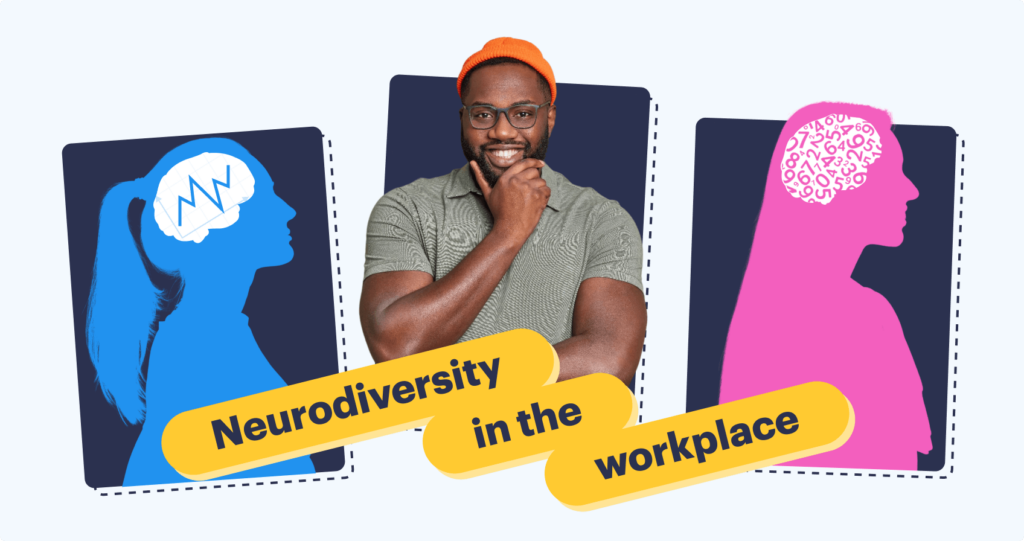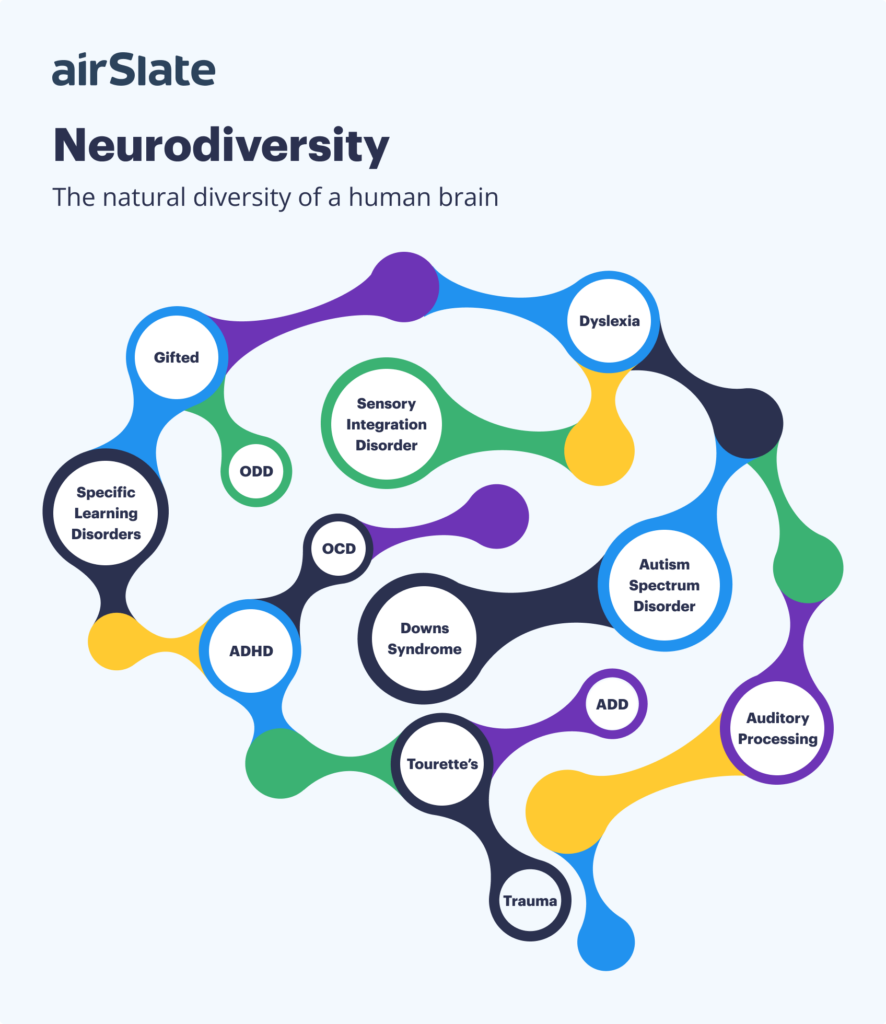How to create a more inclusive hiring and work environment for neurodiversity

The secret is out: workforce diversity is the competitive advantage that will equip your company with the talent, perspective, and skill sets you need to survive and achieve long-term success in a fast evolving world.
While we recognize and embrace our external differences, it is also important to remember that humans come in just as many unique varieties on the inside as they do on the outside.
Could a diverse set of brains in your workforce be the secret ingredient to gaining a competitive edge?
What is neurodiversity?
What if we thought of neurodevelopmental differences or learning disabilities as strengths, instead of weaknesses?
This was the challenge posed to us by the sociologist Judy Singer when she coined the term “neurodiversity” in the late 90’s to describe dyslexia, ADHD, autism, dyspraxia, and other types of brain differences.

Being on the spectrum herself, Singer created this language in hopes of shifting the stigma around these conditions as a “problem to be cured” into a discourse about the benefits of embracing all unique brains, communication styles, and world views.
“It took all my energy to look someone in the eye. If I am looking at you, that’s the one time I know I won’t be listening to you….My nature is not to have friends. I’m happy in my own head.”
— Michael Burry
This is a quote from Michael Burry who is now infamous for his prediction of the market crash of 2008, earning him a net worth of about $300 million.
Michael Burry also has autism. For anyone who knows Burry’s story, his brain is an obvious super power. His different perspective gives him a competitive advantage. This is the kind of fresh viewpoint that can help your team look at things from new angles, or even predict hidden opportunities (or potential catastrophe).
Individuals with neurodivergence such as aspergers or autism can be successful, high functioning employees. But this segment of the population still continues to be underemployed, sometimes due to exhibiting behavior that might be seen as eccentric such as difficulty making eye contact.
Social anxiety is another brain trait that might cause one to appear more standoff-ish, but correlates with important interpersonal skills such as high intelligence and empathy.
Autism is not the only hidden neuro difference that could strengthen your workforce. A worker with Attention-Deficit / Hyperactivity Disorder (ADHD) may be penalized for having a different organizational style, or lacking punctuality.
But, people with ADHD also bring a lot to the table, including natural crisis management skills, the ability to derive patterns from chaos, intuitive empathy, creativity, persistence, resourcefulness, and the ability to hyperfocus on a task for hours on end.
Or perhaps you have encountered a coworker that seems to struggle with perfect spelling, understanding idioms, pronouncing words correctly, or reading aloud. These signs all point to dyslexia. But the dyslexic brain is also wonderful at pattern recognition, big picture thinking, and problem solving.
Why “culture fit” breeds blind spots
As we strive to build a future of work that is equitable for all, that means focusing on creating a culture and work environment that can accommodate all sorts of brains and personality types.
Unfortunately, people with differently abled brains often go overlooked as candidates because they may lack neurotypical traits. These people face a subtle but pervasive type of discrimination that is all too familiar: the idea of “culture fit”.
“Our hiring approach gives everyone on the team veto power. The idea is to hire a someone you would enjoy spending a weekend with,”
— Anonymous startup founder
This anonymous quote from a startup founder highlights the well intentioned, but potentially problematic, idea of hiring for “culture fit”.
“Culture fit” is a term that can enable a company to forgo a candidate with little justification, aside from likability. It encourages the hiring process to become a popularity contest, as opposed to a thorough, rational assessment of skills and capabilities.
Instead of building a diverse set of workers who can bring different perspectives to the table, hiring for culture fit may unintentionally encourage an intrinsic monoculture of “yes people” who are bound to agree on everything.
This is the opposite of building an environment where innovation is able to thrive and flourish, and blindspots are quickly recognized.
The virtual renaissance of workforce inclusivity

But there is a silver lining in all of this. As devastating as the events of 2020 were, it did spur a sort of golden age of virtual recruiting and remote work.
An entirely new landscape of opportunity has opened up for those who might otherwise have been etched out of the workforce due to physical or mental differences.
Underrepresented groups such as women, people of color, and neurodiverse individuals found the interview experience to be less anxiety-inducing, easier to balance, and more accessible when compared to meeting with prospective employers in person.
This new virtual world is also more inclusive for those with physical disabilities or health issues that might prevent them from easily attending interviews or work in person.
These groups were able to conduct interviews with less emphasis placed on physical appearance or personality, bringing the focus to their skills and capabilities instead.
According to the New York Times, students with physical disabilities also found the remote offerings from colleges and universities during the pandemic to be a “lifeline” that in some cases caused them to thrive in their studies.
As exciting as this news is, we can’t forget that building a world that is truly equitable for all is a team effort.
Here’s how you can start:
How to foster neurodiversity in your workforce
1. Communicate your goals and the benefits to key stakeholders and teams
Sometimes eliminating bias can be as simple as shining a light on it with education and understanding. Consider training not only for those who are neurodivergent, but also for managers who can better support a neurodiverse workforce with the proper knowledge and tool kit.
2. Create a safe environment for open conversations
Strive to foster an environment where employees feel comfortable being their authentic selves, and are allowed to celebrate the separate identities which combine to make us who we are: gender, sexual orientation, ethnicity, experiences, and more.
Employee Communities (Employee Resource Groups, or ERGs) are designed to encourage support and foster connections through internal networks.
An employee community centered around mental health or certain types of neurodiversity may provide the support these employees need to be more comfortable with their special abilities. This can also provide a source of mentorship or advice from others who have had similar experiences.
3. Be flexible and accommodating with your working conditions
Workplaces that encourage constant social interaction or insist on micromanaging employee behavior are often the opposite of an effective work environment, especially for neurodivergent individuals.
People with social anxiety or who identify as on the spectrum are more likely to thrive in a virtual, at-home setting. At the very least, accommodations such as noise-canceling headphones, privacy rooms, or flexible work schedules can help your employees stay at their most productive.
4. Rethink your hiring practices
Don’t let a potentially fantastic candidate slip through your fingers due to a blind spot. Avoid hiring on “gut” instinct, which can quickly turn into a popularity contest. Instead, create a structured interview with an objective and measurable assessment system. Base your decision on job competence instead of bravado.
Because neurodiverse traits vary by gender and individual, many people often aren’t diagnosed until later in life. That means resumes don’t tell the whole story. Many exceptional neurodivergent people have to be self taught because of an education system that wasn’t yet able to accommodate their special needs.
5. Use automation
Building systems and safety nets with automation can ensure every individual’s hidden genius is allowed to arrive and thrive at work.
For example, when an individual with ADHD is able to outsource stressful or mundane tasks, this frees up their mind to focus and flourish. Outsourcing excessive busywork with automation can increase your team’s mental bandwidth and reduce room for error.
Instead of being caught up in the grind of detailed daily minutiae, a neurodivergent individual can excel at flexing their inventive imagination, or zooming out to observe a new angle.
At the end of the day, technology is not meant to replace humans. It exists to work for us, so we can do what we’re meant to: bring our own unique brilliance and talents to the table.
Our differences are what make each of us powerful – each in our own way. That is why understanding and embracing neurodiversity can benefit everyone.

